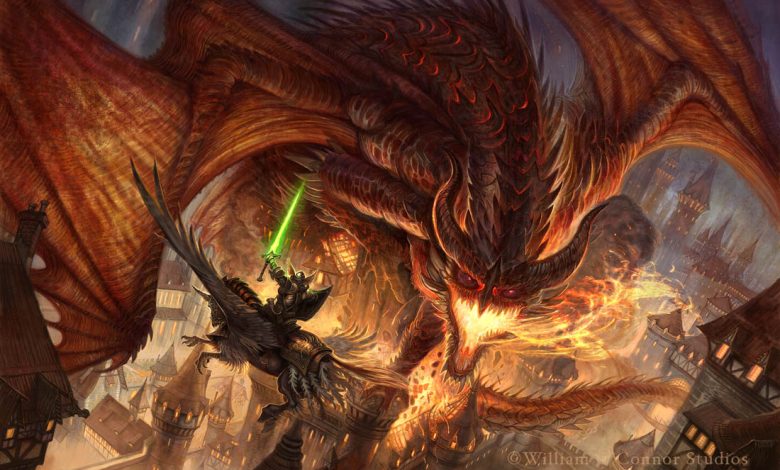Flying Dragon Paintings: What Do They Depict?

Dragons are fabled animals in the tales and myths of numerous cultures worldwide. Dragons have always been depicted as fire-breathing beasts with aggressive personalities, even though they are probably flying creatures with serpent-like traits. However, they have been historically portrayed in various ways depending on different cultures.
There have been some incredible paintings of dragons created by amazing artists. Let’s look at some of the beautiful dragon artworks and what they signify to enthusiasts.
Michael (Raphael)
St. Michael is oil on canvas by Italian painter Raphael. It is housed in the Louver in Paris and is otherwise known as Michael the Little; this distinguishes it from a later related painting, Michael Vanquishing Devil, with a similar thematic portrayal. The painting shows the Archangel Michael engaged in battle with the dragon-like demons of Hell while the damned toil behind him. It is the earliest of Raphael’s paintings on military themes, along with St. George.
This early painting by the artist was created for the Duke of Urbino, Guidobaldo da Montefeltro, on the rear of a drawing board. It is possible that the commission was made to thank Louis XII of France for bestowing the Order of Saint Michael on Guidobaldo’s nephew and heir, Francesco Maria I Della Rovere. Regardless of the inspiration behind its creation, it was hanging in the gallery at the Castle of Fontainebleau by 1548.
The culprits in the backdrop imply that Raphael may have reviewed an illustrated edition of Dante’s Inferno. At the same time, Julia Cartwright speculates that the gold tint on Michael’s green wings may reveal the inspiration of Timoteo Viti. Dante’s condemnation of thieves and hypocrites is reflected in the punishments shown in this magnificent painting.
The Beast from the Sea and the Great Dragon
1805 saw the creation of The Great Red Dragon and the Beast from the Sea. This dragon painting uses a symbolic aesthetic in which each symbol represents a distinct message. For instance, the gigantic red dragon in the picture symbolizes the warnings Christians were given in the book of Revelation.
William Blake, a romantic poet and gifted painter described the ten-horned and seven-headed dragon as the devil, and the beast emerging from the sea has ten horns, a torch, seven heads, and a welding sword. The magnificent painting depicts the Christian faith and the conflict between good and evil as foretold in the Bible tale.
Blake combined many colors with watercolor and illuminated printing to produce a stunning finished piece. In this instance, the pen and ink borders take on a more natural appearance. His artwork endures for a very long time without fading. In order to have a good understanding of what to show, William Blake planned his painting by studying the stories contained in the bible.
Additionally, he creates a printing plate that is backward and uses nitric acid to obliterate the voids at the same time.
The warnings issued to Christians in the book of Revelation led William Blake to design this painting. This painting exemplifies his abilities since he employed a distinctive style to portray the conflict between evil and good.
The Woman Clothed With Sun and the Great Red Dragon
This dragon painting depicts a woman and a dragon, each representing a different book of the bible. It was made between 1805 and 1810 and is currently housed in Washington, DC. Various cautions for Christians are found in the book of Revelation to assist them in upholding their faith.
In this painting, William Blake represents the red dragon with ten horns, crowns, and heads. He did a good job of illuminating the dragon coming down to the sun-clad woman. The moon is beneath the woman’s feet, and she wears a tiara with twelve stars.
In this instance, Blake attempts to seek vengeance on the woman by using the dragon to represent Satan. To complete the forms, this inventive Brit uses watercolors technology, where the application of the stunning gray washes is made. After that, more brushstrokes are used to color the picture.
This method enhances the painting’s beauty for a long time while effectively bringing out the intended meanings. As expressed in the scriptures, the Christian religion is depicted in the picture. Moreover, he illustrated his views with vivid colors.
Saint George and the Dragon by Peter Paul Rubens
This historical dragon painting was finished by Rubens when he was pursuing his artistic education in Italy. Saint George is the patron saint of Genoa, where the artwork was created. The original oil on canvas was painted between 1605 and 1607 and kept in Madrid’s Museo del Prado.
The thirteenth-century “Golden Legend,” which tells the tale of a village destroyed by a dragon, is the inspiration for “Saint George and the Dragon.” To satisfy the dragon, the residents of the town feed two lambs each day. When there are no more sheep, the children are eventually drawn randomly and fed to the dragon.
When the king’s daughter is picked, the monarch offers his money and half of his realm in an effort to save her. However, the child is delivered to the dragon when the villagers reject the king’s proposal. Saint George, who just so happened to be passing, remains with the princess till the dragon appears.
Before riding off on his horse, George performs the Sign of the Cross. The dragon pursues the princess as if she were on a leash, with the princess’s girdle wrapped around its neck. George slays the monster after the community consents to become Christian.
Conclusion
The paintings above demonstrate the significance of dragons in art since they typically represent something that carries deeper meaning in both Christianity and traditional cultures. It is safe to conclude that throughout history and in all civilizations, the dragon has haunted people’s dreams and nightmares and will do so for generations.












